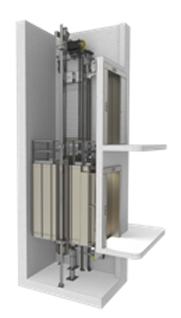A. Elevator with Machine Room (Geared Traction Lifts)
B. Elevator without Machine Room (Gearless Traction Lifts)
Lifts with Machine Room
Traction lifts are lifted by ropes, which pass over a wheel attached to an electric motor above the elevator shaft. They are used for mid and high-rise applications and have much higher travel speeds than hydraulic lifts. A counter weight makes the lifts more efficient by offsetting the weight of the car and occupants so that the motor doesn't have to move as much weight.
Geared Traction Lifts have a gearbox that is attached to the motor, which drives the wheel that moves the ropes. Geared traction lifts are capable of travel speeds up to 500 feet per minute. The maximum travel distance for a geared traction elevator is around 250 feet.
Lifts without Machine Room
The use of passenger lifts without machine room is a perspective direction of world lifts industry's development. The advantages of these lifts provide their wide use in dwelling houses, administrative buildings, hotels, cottages and all kinds of modern buildings.
Gear-less traction Lifts have the wheel attached directly to the motor. Gear-less traction lifts are capable of speeds up to 2,000 feet per minute and they have a maximum travel distance of around 2,000 feet so they are the only choice for high-rise applications.
Geared traction lifts are middle of the road in terms of initial cost, ongoing maintenance costs, and energy consumption. Gear-less traction lifts have a high initial cost, medium ongoing maintenance costs, and use energy a bit more efficiently than geared traction lifts.
The Benefits of Machine-Room less Lifts

Machine-room less lifts (MRLs) offers several advantages over traditional elevator designs. MRLs are a type of traction lifts that do not have a machine room on the top of the hoist way. Instead, the traction hoisting machine is located on the top sidewall of the hoist way or on the bottom of the hoist way. The motor is installed with a permanent magnet and works with Variable Voltage Variable Frequency drive. Some hoisting machines use gearless synchronous motors instead of conventional induction motors.
MRLs use conventional steel cord rope for the hoisting cables. Some manufacturers use flat steel rope belts to save space. MRL lifts are usually used in low- and mid-rise buildings up to 20 floors.There are several benefits to using MRLs. They take up less space and use about 40 percent less electricity than other designs. In addition, they use no oil, which eliminates concerns about leakage and contamination. MRLs also produce less heat and have slightly lower operating costs than traditional lifts. Using them can help a building obtain certification for leadership in Energy and Environment Design from the United States Green Building Council. MRLs were introduced in the 1990s. They have been used in Europe longer than the United States because building codes overseas have adapted to the new technology and designs faster.
The newer elevator models are replacing traditional geared traction lifts and beginning to supplant higher-rise hydraulic lifts. The gearless MRLs are becoming the fastest-growing segment in the North American elevator industry as people move away from hydraulic lifts toward greener technology. MRLs currently account for about one-third of the elevator market.
